If you’re familiar with the darkly funny animated series “South Park,” you know there’s nothing that tubby 9-year-old Eric Cartman hates more than hippies. In the 2005 episode “Die Hippie, Die,” he gallantly waddles from house to house with an exterminator tank, hell-bent on ridding the neighborhood of the bad-smelling, peace-preaching stoners. Well, in my small hometown in the late 1960s, we had but one authentic hippie, and we intended to keep him.
By the time the Age of Aquarius hit Pennsyltucky, it was already the Age of Libra. For years we stared at our cabinet TVs with envy at the scenes of flower-children burning draft cards in Chicago, marching for peace in D.C., and dancing in a hallucinogenic stupor in Golden Gate Park. Just when we’d nearly given up hope that we’d ever be hip, God answered our prayers and gave us something to break the monotony of our boring, bourgeois lives: a bearded, long-haired, blurry-eyed, sandaled dude whom the town elders affectionately called “The Dirty Hippie.” So touched was he by this moniker that he actually painted the nom de freak on the side of his psychedelically embellished pickup truck. You bet your bippy! What a treat to see him whiz by — “Sunshine of your Love” and fragrant smoke wafting from his windows — as we walked home from school. “Hey look! It’s the Dirty Hippie!” we’d cry out as we waved. I have no idea whether our token tokin’ rebel embraced the make-love-not-war ideology of the times, but he looked like he stepped right out of central casting for “Easy Rider.” And that was good enough for us. We didn’t want any trouble-making pinko types, anyway. We weren’t ready for our small hamlet to become infested with the city-bred rodent variety of hippie — like those personified by David Peel.
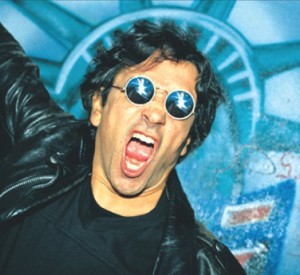 I was 12 years old, watching The David Frost show on TV after school, when I discovered Mr. Peel. As the veddy, veddy British talk show host introduced a musical number, I was delighted to see John Lennon on stage with an assortment of musicians I didn’t recognize. But why was John (and the ubiquitous Yoko) standing in the back, banging away on a homemade stringed instrument, and not in the spotlight? Who was the wire-haired dude with Lennonesque granny glasses shouting into the microphone? And why was he singing funny lyrics to Merle Haggard’s “Okie from Muskogee” song? This was too much!
I was 12 years old, watching The David Frost show on TV after school, when I discovered Mr. Peel. As the veddy, veddy British talk show host introduced a musical number, I was delighted to see John Lennon on stage with an assortment of musicians I didn’t recognize. But why was John (and the ubiquitous Yoko) standing in the back, banging away on a homemade stringed instrument, and not in the spotlight? Who was the wire-haired dude with Lennonesque granny glasses shouting into the microphone? And why was he singing funny lyrics to Merle Haggard’s “Okie from Muskogee” song? This was too much!
I’m proud to be a New York City hippie / I’m proud of dirty feet and dirty hair.
I’m proud of living with the cock-a-roaches / I’m proud of living in a garbage can.
We want to warn you squares and all you rednecks: If you hate the hippies from New York,
We’ll unify the hippies from the country /We’ll fight until the South becomes the North.
Wow! The high literature of Mad magazine set to music! This truly appealed to my 7th grade brain. I would never forget this TV performance, or the name of the singer, David Peel. And I vowed that one day I would learn all about this dirty hippie.
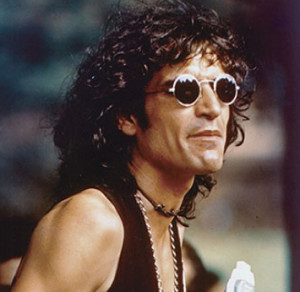 Born David Michael Rosario in Brooklyn, Peel was, and remains, a singer, songwriter, musician, activist, street performer, and self-described radical. In 1968, he and his band, The Lower East Side, landed a contract with Elektra Records and subsequently released two albums that were groundbreaking in theme and content: “Have a Marijuana” and “The American Revolution.” Kudos to Elektra for releasing LPs with song titles like “I’ve Got Some Grass,” “Hey Mr. Draft Board,” “I Want To Get High,” “Show Me the Way to Get Stoned,” and the police-hating “Oink, Oink.” Smells like early punk rock to me.
Born David Michael Rosario in Brooklyn, Peel was, and remains, a singer, songwriter, musician, activist, street performer, and self-described radical. In 1968, he and his band, The Lower East Side, landed a contract with Elektra Records and subsequently released two albums that were groundbreaking in theme and content: “Have a Marijuana” and “The American Revolution.” Kudos to Elektra for releasing LPs with song titles like “I’ve Got Some Grass,” “Hey Mr. Draft Board,” “I Want To Get High,” “Show Me the Way to Get Stoned,” and the police-hating “Oink, Oink.” Smells like early punk rock to me.
Peel has been described as the Woodie Guthrie of Yippie politics. He prided himself on being a street musician – of the people, by the people, for the people – and gained most of his notoriety shouting out his satirical ditties in Washington Square Park in Greenwich Village. Still, outside of New York counter-culture society, Peel remained very much an underground novelty. Until another radically minded singer-songwriter happened upon his act.
One day in 1971, two newly-minted New Yorkers, John and Yoko Ono Lennon, wandered into Washington Square Park with their friend, rock journalist and producer Howard Smith. There, John saw Peel for the first time. The street singer shouted out something like, “Why do you have to pay to see stars?” John thought that Peel was referring to him, and his interest was piqued. It wouldn’t be long before Yippie leaders Jerry Rubin and Abbie Hoffman would lead John back to the park and introduce him to Peel. They hit it off immediately. “He’s such a great guy,” said Lennon in 1972. “We loved his music and his spirit and everything — his whole philosophy of the street.”
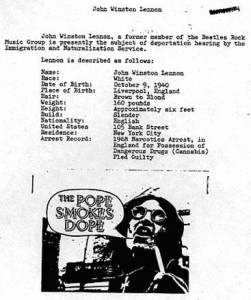 The next thing you know, John signs Peel to The Beatles’ Apple Records (against the objections of some of his former bandmates) and is producing his infamous LP, “The Pope Smokes Dope.” Its title song, along with such tunes as “F is Not a Dirty Word,” “I’m Gonna Start Another Riot,” and “The Birth Control Blues” ensured that the LP would be banned in nearly every country except the United States and Canada. Now, with John’s blessing and a banned record, Peel not only was the new darling of the anti-establishment, he had a free pass to enter the living rooms of Middle America by way of the David Frost show. With his round, wire-rimmed sunglasses and prominent nose, he looked so much like John that the FBI mistakenly used his photo in a fact sheet they produced for Nixon’s “deport Lennon” campaign.
The next thing you know, John signs Peel to The Beatles’ Apple Records (against the objections of some of his former bandmates) and is producing his infamous LP, “The Pope Smokes Dope.” Its title song, along with such tunes as “F is Not a Dirty Word,” “I’m Gonna Start Another Riot,” and “The Birth Control Blues” ensured that the LP would be banned in nearly every country except the United States and Canada. Now, with John’s blessing and a banned record, Peel not only was the new darling of the anti-establishment, he had a free pass to enter the living rooms of Middle America by way of the David Frost show. With his round, wire-rimmed sunglasses and prominent nose, he looked so much like John that the FBI mistakenly used his photo in a fact sheet they produced for Nixon’s “deport Lennon” campaign.
While John went on to produce Peel’s single, “America,” for the soundtrack of the film “Please Stand By,” Apple records did not renew his contract. Wary of censorship battles with established record labels, he formed an independent company, Orange Records, to release his own material and that of other artists. His 1976 LP, “An Evening With David Peel,” has been praised for perfectly capturing the sound and spirit of the chaotic early ’70s underground movement. He’s been recording, without fanfare, for decades. You can download his songs from iTunes and Amazon.com.
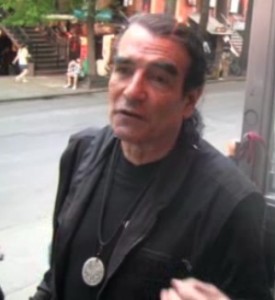
Thanks to Lennon’s association, Peel went from playing parks to stadiums, alongside such artists as Rod Stewart, B.B. King, Alice Cooper, Dr. John, Frank Zappa, Iggy Pop, MC5, John Lee Hooker, Roger McGuinn, Richie Havens, Odetta, Arlo Guthrie, Stevie Wonder, Joan Baez, Cypress Hill, and The Ramones.
But despite his high profile gigs, Peel’s always felt most comfortable on the streets of New York, performing gratis for everyday people. At age 70, he’s still a bachelor, sans children, and lives in a rent-controlled apartment on Avenue B in the East Village. He gets by on songwriting royalties, sales of old records, and the occasional gig. He’s made a comeback in recent years, writing songs for the Occupy Wall Street movement and singing and strumming his way into the hearts of a new generation of rabble rousers. He told a New York Times reporter in 2012 that he plans to continue to sing on the streets and in the parks “until the day I drop dead and go to rock ’n’ roll heaven.”
Let’s just hope there’s plenty of weed behind those pearly gates — if the popes haven’t smoked it all up, that is.
UPDATE: I just leaned that Mr. Peel died on April 6, 2017, following a heart attack. Wherever you are, David, keep stirring the pot!
Here’s David Peel and The Lower East Side, along with John, Yoko, and Jerry Rubin, performing “Hippie from New York City” on David Frost’s show in 1972. It’s a biting parody of Merle Haggard’s “Okie from Muskogee.”
Here are audio clips of John, discussing David’s appeal: “People say, ‘Oh, you know Peel – he can’t sing, or he can’t really play and that,’ but he writes beautiful songs, you know, and even sort of as simple as his basic chord structures are, supposedly. Well you know, Picasso spent 40 years trying to get as simple as that.”
This South Park clip is from the episode called “Die Hippie, Die,” which shows Eric Cartman trying to rid the town of hippies.
© Dana Spiardi, March 6, 2013
]]>
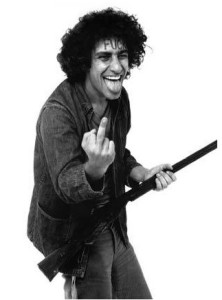 Attention: this is an important history lesson for all you sweet young things born after the baby boom! The subject is Abbie Hoffman, who died 25 years ago today. He was one of the most colorful pranksters and political activists of the 1960s, and a hero to many. He was a founder of the Youth International Party (Yippies) and one of the “Chicago Seven,” a group arrested for conspiracy and inciting a riot during the 1968 Democratic National Convention. His outlandish behavior inspired many to become politically active, question authority and protest the Vietnam war. What an adorable little bad-ass Jew!
Attention: this is an important history lesson for all you sweet young things born after the baby boom! The subject is Abbie Hoffman, who died 25 years ago today. He was one of the most colorful pranksters and political activists of the 1960s, and a hero to many. He was a founder of the Youth International Party (Yippies) and one of the “Chicago Seven,” a group arrested for conspiracy and inciting a riot during the 1968 Democratic National Convention. His outlandish behavior inspired many to become politically active, question authority and protest the Vietnam war. What an adorable little bad-ass Jew!
The Nixon government considered him a subversive, due to his association with such controversial groups as the Black Panthers, the Student Nonviolent Coordinating Committee (SNCC) and the Socialist Workers Party (SWP). His FBI file consisted of over 13,000 pages.
One of his grand symbolic stunts involved taking a group of Yippie followers to the New York Stock Exchange in 1967, where they tossed both real and phony dollars from the gallery, amusing themselves as traders went wild trying to catch the falling bills. No one in Hoffman’s entourage even thought to alert the press ahead of time, but the story spread like wildfire through the media. As a result of the prank, the NYSE spent $20,000 to enclose the gallery with bulletproof glass.
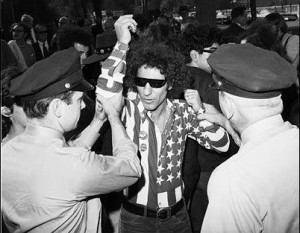 Another of his capers involved leading a group of war protestors to the Pentagon, only to find that a throng of soldiers had formed a human chain to prevent them from nearing the building. Abbie suggested the use of psychic energy to levitate the Pentagon until it turned bright orange and began to vibrate – thus bringing the Vietnam war to an end. Allen Ginsberg was on hand to lead the crowd in Tibetan chants. Oh, what a time!
Another of his capers involved leading a group of war protestors to the Pentagon, only to find that a throng of soldiers had formed a human chain to prevent them from nearing the building. Abbie suggested the use of psychic energy to levitate the Pentagon until it turned bright orange and began to vibrate – thus bringing the Vietnam war to an end. Allen Ginsberg was on hand to lead the crowd in Tibetan chants. Oh, what a time!
The courtroom trial of the Chicago Seven was like a scene from a Marx Brothers movie. Abbie and fellow defendant Jerry Rubin wore judicial robes to court one day. As Abbie was being sworn in, he managed to flash the finger while his hand was on the bible. When asked to give his state of residence, he replied, “the state of mind of my brothers and sisters.” He led his codefendants in daily harassments of Judge Julius Hoffman (no relation). Abbie told the judge, “you are a ‘shande fur de Goyim’ [disgrace in front of the gentiles]. You would have served Hitler better.” During the trial he repeatedly called the judge “Julie,” and even suggested he try LSD, promising to set him up with a dealer in Florida.
 Abbie and four of his codefendants – Rubin, David Dellinger, Rennie Davis, and Tom Hayden (who later married Jane Fonda after their controversial jaunt to North Vietnam in 1972) – were found guilty of “intent to incite a riot while crossing state lines.” They were fined $5,000 and sentenced to five years in prison, but the convictions were later overturned when a commission ruled that a “police riot” caused the violent clashes at the Democratic convention.
Abbie and four of his codefendants – Rubin, David Dellinger, Rennie Davis, and Tom Hayden (who later married Jane Fonda after their controversial jaunt to North Vietnam in 1972) – were found guilty of “intent to incite a riot while crossing state lines.” They were fined $5,000 and sentenced to five years in prison, but the convictions were later overturned when a commission ruled that a “police riot” caused the violent clashes at the Democratic convention.
When Abbie was convicted for wearing a shirt resembling the American flag – which police had torn from his back – he announced, Nathan Hale-style, “I only regret that I have but one shirt to give for my country.” (To make matters worse, he had a Viet Cong flag painted on his back.)
Through the years Abbie continued to stir things up. He jumped on stage while The Who were performing at Woodstock, and delivered an LSD-fueled message: “I think this is a pile of shit while [militant counterculture leader] John Sinclair rots in prison.” Pete Townshend charged at him, whacking him with his guitar for violating the “sanctity of the stage.” (Townshend denied striking him; accounts vary.)
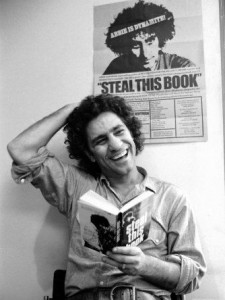 In 1973, police nabbed Abbie for “intent to sell and distribute cocaine.” Maintaining that he was framed, he skipped bail, underwent plastic surgery and went into hiding, finally surrendering in 1980 (he served a four month sentence). In 1986, he (along with President Carter’s daughter Amy) was arrested for trespassing during a protest of CIA actions on the campus of the University of Massachusetts at Amherst.
In 1973, police nabbed Abbie for “intent to sell and distribute cocaine.” Maintaining that he was framed, he skipped bail, underwent plastic surgery and went into hiding, finally surrendering in 1980 (he served a four month sentence). In 1986, he (along with President Carter’s daughter Amy) was arrested for trespassing during a protest of CIA actions on the campus of the University of Massachusetts at Amherst.
Along the way, he authored the wildly popular guide to political activism, “Steal This Book,” and, with Jonathan Silvers, co-authored “Steal This Urine Test,” which exposed the flaws in the government’s war on drugs.
As the Reagan ’80s progressed, Abbot Howard Hoffman remained active in social causes, but was battling bi-polar disorder and no doubt bemoaning the lack of activism among young people. On April 12, 1989, at age 52, he washed down 150 phenobarbital tablets with liquor. Some say it was an unintentional overdose, but swallowing 150 pills does require some effort on the part of even the most experienced aficionado. It was ruled a suicide.
Abbie would have approved of the eulogy delivered by Rabbi Norman Mendell, who said that his activism and rabble-rousing were in keeping with “the Jewish prophetic tradition, which is to comfort the afflicted and afflict the comfortable.”
Now, let’s all steal THAT philosophy!
“Revolution is not something fixed in ideology, nor is it something fashioned to a particular decade. It is a perpetual process embedded in the human spirit.”
After Abbie told a Chicago city official that he’d take $100,000 to call off the massive demonstration planned for the 1968 Democratic Convention, a reporter asked him if he was serious. Here’s what he said.
By Dana Spiardi, April 12, 2014
]]>
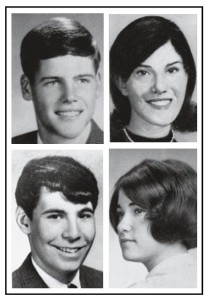 I’m referring, of course, to the Kent State University killings of May 4, 1970. Here’s the story, which we all (should) know: Students at the university were protesting America’s escalating involvement in the Vietnam War. National Guard troops, called in to control the crowds, opened fire and killed four unarmed activists. The Guardsmen claimed the students were becoming unruly and aggressive when told to disperse, and said they fired on the crowd in self defense: between 61 and 67 shots in a 13 second period. Eight Guardsmen were indicted, but in 1974 a federal judge dismissed the case against them. The victims are shown in this photo, clockwise from top left: William Schroeder, Allison Krause, Sandra Lee Scheuer, and Jeffrey Miller. Nine others were wounded.
I’m referring, of course, to the Kent State University killings of May 4, 1970. Here’s the story, which we all (should) know: Students at the university were protesting America’s escalating involvement in the Vietnam War. National Guard troops, called in to control the crowds, opened fire and killed four unarmed activists. The Guardsmen claimed the students were becoming unruly and aggressive when told to disperse, and said they fired on the crowd in self defense: between 61 and 67 shots in a 13 second period. Eight Guardsmen were indicted, but in 1974 a federal judge dismissed the case against them. The victims are shown in this photo, clockwise from top left: William Schroeder, Allison Krause, Sandra Lee Scheuer, and Jeffrey Miller. Nine others were wounded.
Gerald Casale, Mark Lewis and Mike Mothersbaugh were studying art at the college at the time of the tragedy. In the late ’60s they had become fascinated with the idea that society was regressing rather than evolving – de-evolving, so to speak. War, assassinations, civil unrest — it all fed into the mix. They began developing an interest in satirical art that reflected America’s increasing dysfunction and conformity. But what began as parody soon became deadly serious after the campus massacre on May 4. When the three friends formed a post-punk/art-rock band a few years later, they named it Devo, a shortened form of devolution.
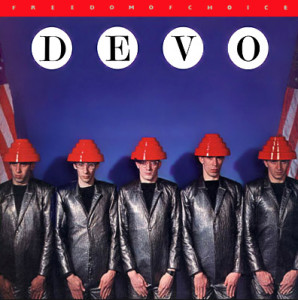 “All I can tell you is that it completely and utterly changed my life,” Gerald Casale told Brian L. Knight of The Vermont Review. “I was a white hippie boy and then I saw exit wounds from M1 rifles out of the backs of two people I knew. Two of the four people who were killed, Jeffrey Miller and Allison Krause, were my friends. We were all running our asses off from these motherf**kers. It was total utter bullshit. Live ammunition and gasmasks – none of us knew, none of us could have imagined. They shot into a crowd that was running. I stopped being a hippie and I started to develop the idea of devolution. I got real, real pissed off.”
“All I can tell you is that it completely and utterly changed my life,” Gerald Casale told Brian L. Knight of The Vermont Review. “I was a white hippie boy and then I saw exit wounds from M1 rifles out of the backs of two people I knew. Two of the four people who were killed, Jeffrey Miller and Allison Krause, were my friends. We were all running our asses off from these motherf**kers. It was total utter bullshit. Live ammunition and gasmasks – none of us knew, none of us could have imagined. They shot into a crowd that was running. I stopped being a hippie and I started to develop the idea of devolution. I got real, real pissed off.”
Although Devo never recorded a song specifically about the massacre, Casale once told Hustler magazine, “I don’t think I would have started Devo without that change in me.”
The most famous song to emerge from the tragedy was Crosby, Stills, Nash and Young’s “Ohio,” written by Neil Young and released one month after the killings. It peaked at number 14 on the Billboard charts. Through the years, artists have recorded at least 30 lesser-known songs about the slaughter. Here are a few.
Steve Miller’s “Jackson-Kent Blues” appeared on his 1970 album “Number 5.” This song addressed both the Kent State incident and a tragedy on May 15, 1970, in which police opened fire on Vietnam War protestors at Jackson State University, killing two and injuring five. (The words of the song are hard to decipher. Click here to see the lyrics. )
The Beach Boys recorded “Student Demonstration Time” for their 1971 album “Surf’s Up.” It’s based on the song “Riot In Cell Block Nine,” written by Jerry Leiber and Mike Stoller. Beach Boy Mike Love wrote new lyrics to the original melody.
Genesis recreated the Kent State events from the perspective of the National Guard in their 1970 song “The Knife.” Voices of the students chant “We are only wanting freedom,” as a male voice calls out, “Things are getting out of control here today,” followed by “Okay men, fire over their heads!” Sounds of gunshots, screaming and crying are interwoven into the song.
Joe Walsh, who briefly attended Kent State, wrote 1972’s “Turn to Stone” in response to the shootings. He also mentions the event in the 1992 song “Decades.”
A very young Bruce Springsteen wrote the unreleased “Where was Jesus in Ohio” in 1970 as a response to the killings. Here’s a rare recording of the song:
Jon Anderson of Yes said that some of the lyrics of “Long Distance Runaround” from band’s 1971 album “Fragile” were inspired by the Kent State murders, particularly the line “hot color melting the anger to stone.”
Dave Brubeck wrote his 1971 cantata “Truth Is Fallen” in direct response to the tragedies at Kent State University and Jackson State University.
And, of course, here’s the most famous song of all:
For the record, Chrissie Hynde of The Pretenders was also a Kent State student at the time of the shootings; she knew slain student Jeffrey Miller. Like so many others, she dropped out of school after the killings.
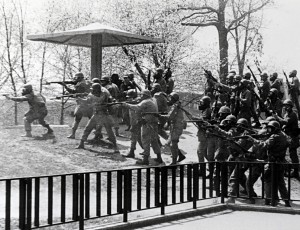 In many respects, Kent State marked the end of the peace-and-love Woodstock era. Said Gerald Casale to Mark Frauenfelder of Boing Boing in 2010, “Until then I was a hippie. I thought that the world is essentially good. If people were evil, there was justice… and that the law mattered. All of those silly naïve things. I saw the depths of the horrors and lies and the evil. The paper that evening, the Akron Beacon Journal, said that students were running around armed and that officers had been hurt. So deputy sheriffs went out and deputized citizens. They drove around with shotguns and there was martial law for ten days. 7 PM curfew. It was open season on the students. We lived in fear. Helicopters surrounding the city with hourly rotating runs out to the West Side and back downtown. All first amendment rights are suspended at the instant the governor gives the order. All of the class-action suits by the parents of the slain students were all dismissed out of court, because once the governor announced martial law, they had no right to assemble.”
In many respects, Kent State marked the end of the peace-and-love Woodstock era. Said Gerald Casale to Mark Frauenfelder of Boing Boing in 2010, “Until then I was a hippie. I thought that the world is essentially good. If people were evil, there was justice… and that the law mattered. All of those silly naïve things. I saw the depths of the horrors and lies and the evil. The paper that evening, the Akron Beacon Journal, said that students were running around armed and that officers had been hurt. So deputy sheriffs went out and deputized citizens. They drove around with shotguns and there was martial law for ten days. 7 PM curfew. It was open season on the students. We lived in fear. Helicopters surrounding the city with hourly rotating runs out to the West Side and back downtown. All first amendment rights are suspended at the instant the governor gives the order. All of the class-action suits by the parents of the slain students were all dismissed out of court, because once the governor announced martial law, they had no right to assemble.”
Tin soldiers. Four dead in O-hi-O.
© Dana Spiardi, May 4, 2014
]]>
So, what song could the defense attorney possibly be citing? It’s 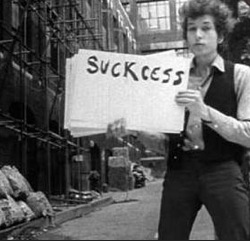 Bob Dylan’s word-twister from 1965, “Subterranean Homesick Blues,” one of the most influential and imitated songs in popular music. With its random satirical lyrics delivered in rapid-fire deadpan style, Bob takes aim at the emerging social strife of the day: civil rights battles (better stay away from those that carry around a fire hose), the burgeoning drug scene (Johnny’s in the basement mixing up the medicine), and authority figures (don’t follow leaders / watch the parking meters.) It’s like a sociopolitical jump rope chant.
Bob Dylan’s word-twister from 1965, “Subterranean Homesick Blues,” one of the most influential and imitated songs in popular music. With its random satirical lyrics delivered in rapid-fire deadpan style, Bob takes aim at the emerging social strife of the day: civil rights battles (better stay away from those that carry around a fire hose), the burgeoning drug scene (Johnny’s in the basement mixing up the medicine), and authority figures (don’t follow leaders / watch the parking meters.) It’s like a sociopolitical jump rope chant.
But the lyric that’s best remembered is: You don’t need a weatherman to know which way the wind blows. And, according to a 2007 study by Alex Long, that line has been quoted by judges, lawyers, and law scholars more than any other lyric from popular music. Mr. Long is a University of Tennessee law professor who spent an entire semester back in 2007 researching the use of popular song lyrics in court findings and legal publications. He found that half a dozen California appellate court rulings have used Dylan’s weatherman line to show that testimony is unnecessary to make a point that would be obvious to any layman.
Bob Dylan’s poetic, often stinging lyrics have long served as a social barometer. In addition to “Subterranean Homesick Blues,” many of his tunes have shown up in legal proceedings and briefs. According to Long, as of 2007, Dylan, lines had been quoted 186 times. Compare this to the lyrics of The Beatles, 74; Bruce Springsteen, 69; Paul Simon, 59; Woody Guthrie, 43; the Rolling Stones, 39; the Grateful Dead, 32; Simon & Garfunkel, 30; Joni Mitchell, 28; and R.E.M., 27.
So, if you ever get hauled before the judge, you’d better hope your lawyer was a ’60s hipster or a modern day Dylan devotee. To paraphrase Bobby: better stay away from those / who Dylan songs they don’t knows.
Below is a short commentary on the making of the famous “Bob in the alley” music video for “Subterranean Homesick Blues.” It’s from D.A. Pennebaker’s Dylan documentary, “Don’t Look Back.” Saint Allen Ginsberg is in the background – on the pavement, thinking about pissing off the government. Bob once said he based the lyrical style of the song on Chuck Berry’s famous scat record “Too Much Monkey Business.“
© Dana Spiardi, May 24, 2014
 He loosely based the song on an upbeat Chuck Berry number from 1958, “You Can’t Catch Me,” which features the line, here come a flat-top, he was moving up with me. John opened his version with the now-famous words, here come old flat-top, he come groovin’ up slowly. Throughout the song John does his best to match the rocking-rap lyrical style and rhythm that Chuck was famous for. He was, after all, one of Berry’s biggest fans. John once said, “If you tried to give rock and roll another name, you might call it ‘Chuck Berry.'”
He loosely based the song on an upbeat Chuck Berry number from 1958, “You Can’t Catch Me,” which features the line, here come a flat-top, he was moving up with me. John opened his version with the now-famous words, here come old flat-top, he come groovin’ up slowly. Throughout the song John does his best to match the rocking-rap lyrical style and rhythm that Chuck was famous for. He was, after all, one of Berry’s biggest fans. John once said, “If you tried to give rock and roll another name, you might call it ‘Chuck Berry.'”
Back at Abbey Road studios, Paul McCartney suggested John slow down the tempo of the song and add a heavy bass line to give it a more bluesy feel. Though most Beatle fans undoubtedly missed the musical and lyrical similarities to Chuck’s original, music publisher Morris Levy did not. Levy owned the rights to Berry’s material and sued Lennon. To settle the case, John agreed to record three other songs owned by Levy’s publishing company. Two of these – “Ya Ya” and “You Can’t Catch Me” were included on John’s 1975 “Rock-n-Roll” LP. A third – “Angel Baby” – was released after his death.
I’ll never forget hearing “Come Together” for the first time, when I was 10 years old. My mother had just come home from shopping and presented me with the latest Beatles LP, “Abbey Road.” I immediately placed the needle of my trusty old Sears Silvertone record player on the first track, and WOW. I was totally knocked out: Ringo’s cascading drum roll intro, John’s nasal sneering voice, Paul’s swampy bass, George’s minimalist, stinging guitar riffs in the closing. It is one of the Beatles’ most unique songs and is the perfect kick-off to a phenomenal album — the last one the Beatles would record together. So it goes that in the summer of 1969 those bickering boys managed to come together one last time to create a masterpiece. And rock history is all the richer for it.
Here’s John performing “Come Together.” The song hit #1 in the U.S. in October 1969 and spent 16 weeks on the charts.
Here’s Chuck Berry’s “You Can’t Catch Me.”
© Dana Spiardi, Feb. 4, 2014
]]>
